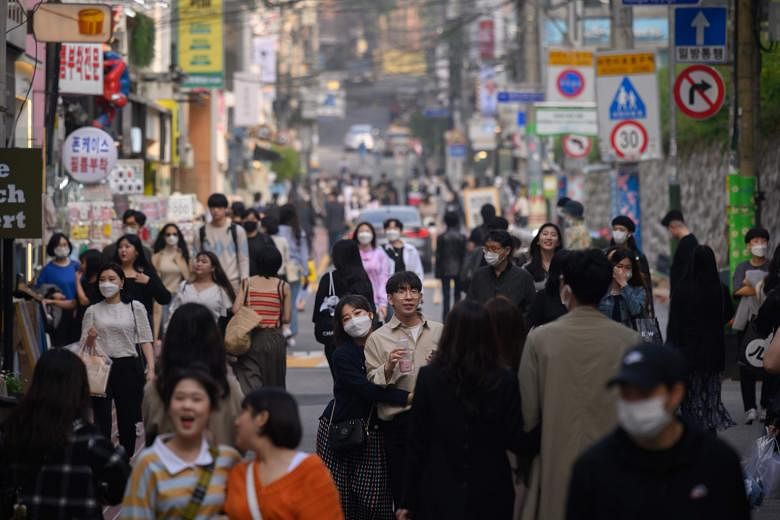Plans by more countries to ease their lockdowns are igniting hopes that an economic recovery - albeit modest - could take hold.
Governments are eager to reopen and resume economic activity to save jobs and businesses as the number of daily fatalities and the transmission potential of Covid-19 continue to fall.
Still, with no certainty on the availability of a vaccine or achieving herd immunity, policymakers are reluctant to lift all the curbs.
So the path to recovery is unlikely to be smooth as long as the fear of a second wave of new infections persists.
Singapore is among several countries that have decided to loosen some of the measures and start to reopen their economies.
So far, China and South Korea are the only large nations to have eased restrictions enough to move the dial on economic activity.
Norway and Denmark eased restrictions in the middle of last month, while Spain and Germany have taken some tentative steps.
Italy began to ease the curbs early this month and France has also outlined its exit plans.
In the United States, 29 of the 50 states have loosened restrictions and a heated debate is ongoing over the trade-off between lives and livelihoods.
Britain and Russia are the latest to relax lockdowns, both allowing workers in construction and parts of manufacturing to return to work.
Meanwhile, India and Japan are extending their lockdowns but relaxing the rules for areas with fewer reported cases.
However, financial markets have already moved on, rebounding from the rout in March with risk aversion softening in stocks, credits, commodities and currencies worldwide.
The early rounds of stock market rallies were dominated by institutional investors - such as mutual funds, pensions and endowments - who needed to put to work the massive pile of cash they are still on.
Given that most markets have yet to recover all of their recent losses, there is still room for upside.
But retail investors will be taking a huge risk if they blindly follow the upswing.
They should act like smart money has so far and focus on opportunities in companies and sectors that were least impacted by the pandemic or are likely to rebound strongly when the cycle turns.
Economists are trying to measure the pace of the planned reopening and the subsequent shape of recovery by crunching both hard and high-frequency data, especially from countries such as China and South Korea that were the first to ease some of the preventive measures.
Even as data shows an encouraging rebound in economic activity in these two countries, the easing of curbs resulted in new but smaller outbreaks of infections.
Fitch Ratings research arm Fitch Solutions said: "This suggests that the road to recovery will be very bumpy as many countries will be forced to delay easing measures, or - in a worst-case scenario - clamp down following new outbreaks."
The speed at which countries can reopen their economies will also depend on the political trade-off between public health and the economy, with policymakers essentially having to decide how much risk of a second outbreak they will accept as they reopen, Fitch said this week.
At the same time, the sharp rise in unemployment and fiscal deficits and much lower economic growth over the next year or so will force many governments into a corner as they decide how to allocate the cost of fiscal consolidation - such as higher taxes and spending cuts - between the different segments of society.
Schroders Investment Management said investors should be particularly wary of India, Russia and Canada, which are at the highest risk of a second wave.
The risk is lower for the US and Europe but still remains, and they should be careful of exiting lockdown too quickly, Schroders said, basing its analysis on the effective reproduction number of infections.
"In terms of what this means for the global economic recovery, there is still a clear risk of a W-shape recovery, particularly if lockdowns are eased too quickly or lockdown fatigue sets in," it said.
Keeping in view the risk of a fresh outbreak, Singapore has decided to follow a step-by-step plan to reopen the economy.
That means the economic recovery is also going to be staggered and will need more fiscal support, hence a new support package set to be announced next week.
The consensus view has more or less given up any hope of a recovery starting any time in the second quarter of this year.
In fact, most analysts agree that headline data will be quite devastating for most major economies and may require a lower adjustment for full-year growth forecasts.
But a strong consensus is also emerging for a tepid recovery starting in the third or fourth quarter, even without a vaccine.
Mr Andrew Slimmon, head of the applied equity advisers team at Morgan Stanley Investment Management, said: "Any re-outbreak of the virus is more or less anticipated - and therefore will not cause the damage to the stock market that it did initially when we knew nothing about Covid-19."
With countries reopening, the economic data should begin to inflect more positively, which ought to take out the risk of markets retesting their lows for this year.
Mr Slimmon said there are numerous companies that are market leaders with strong balance sheets, but operate in industries that have been hurt by the economy being shut down.
The result is that they have been jettisoned by investors and are unusually cheap. To avoid this opportunity to buy such stocks is to presuppose that there will never be a vaccine, he said.
"I think that is shortsighted. By the time there is a vaccine, these stocks should be substantially higher," Mr Slimmon added.
"My advice is to not let your emotions about the virus impact your investment position. Do not sell in the weakness or buy in the strength."


